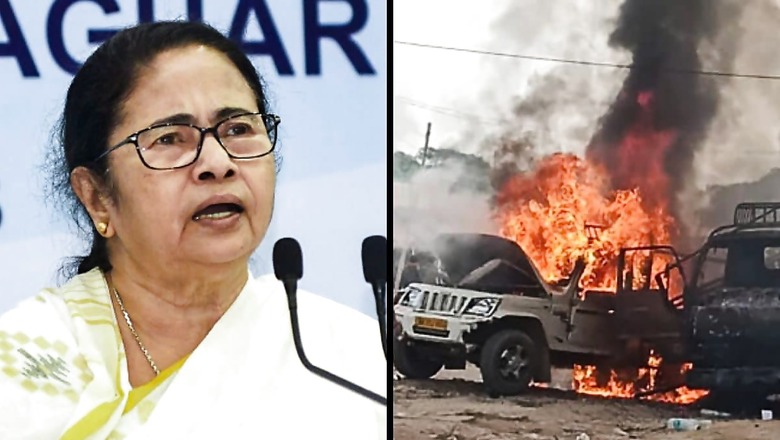
views
Seventy people were killed in political violence during the process of panchayat polls in 2003, 36 were killed in 2008 and 39 were killed in 2013 — the figures have not been taken from an undisclosed or confidential government report, but from West Bengal chief minister Mamata Banerjee’s speech.
Debunking the idea of deploying central forces for panchayat polls, due in July, Banerjee said, “Central forces were deployed in the 2013 panchayat polls. How many people died? 39. During the Left rule, in 2003, around 70 people were killed in panchayat polls and in 2008 panchayat polls, around 36 people were killed,” said Banerjee, while addressing a public meeting in South24 Paraganas’ Kakdwip.
Referring to the violence in Bhangar in the district, she further added, “In Bhangar, some goondas (hooligans) created trouble. The Trinamool Congress (TMC) has no role to play. In fact, two of my party members were killed.”
The figures of death during the panchayat polls over two decades sum up the extent of political violence and its tendency to spiral. The chief minister’s speech comparing data of deaths and other regimes also seems to be a way to justify the violence this year, and “normalise” violence as an “instrument to win” elections, say political experts.
PARTIES CHANGE, VIOLENCE REMAINS
West Bengal has not witnessed a violence-free election — starting from a panchayat poll or a municipal election to assembly or Lok Sabha polls — over the past four two decades. Images and clips of hurling ‘hand-made’ bombs, spraying bullets from improvised guns, killing of people and arson always flood the social media, make headlines for newspapers and news channels. The political parties, ruling and Opposition change, but violence remains.
Talking to News18, Samir Dar, professor of political science in Calcutta University, said, “Violence and polls are a lethal combination in Bengal. The politicians here have lost control over the electorate and that is why they always encourage their cadre to indulge in violence. The idea of eliminating Opposition forces, and thereby leaving the electorate with no choice is the way of conducting polls here. That is why, in 2018, over 30% of the total seats remained uncontested. We cannot accuse any particular party, across the board, the parties fight to retain control over the instruments of violence.”
Before 2011, it used to be between the Communist Party of India (Marxist) (CPM) and Congress, the CPM and TMC, and post 2014, it became the TMC and Bharatiya Janata Party (BJP), Congress and CPM, and sometimes it is between two factions of the TMC. This year, the warring groups have changed.
In South 24 Paraganas’ Bhangar, the fight was primarily between the TMC and Indian Secular Front (ISF). ISF’s Nausad Siddiqui is the first MLA of his party who won against the ruling Trinamool in Bhangar.
Three people — one ISF and two Trinamool workers — were killed in the violence in Bhangar during the nomination process last week. The clashes were accompanied by vandalism and arson in the area.
THE MUSLIM VOTE BANK
Even though sporadic clashes were reported from Murshidabad, where a Congress worker was allegedly killed, and from North Bengal’s Cooch Behar and Uttar Dinajpur districts, unbridled violence continued for days in Bhangar. Visuals of villagers hurling petrol bombs or other crude bombs and shooting at each other were commonplace.
The clash started between the workers of ISF and Trinamool Congress, said the villagers, with whom News 18 spoke. The ISF was floated by Peerzada Abbas Siddique in 2021, who rebelled against his family’s loyalty towards Didi. The family of Peerzada (Muslim clerics and spiritual leaders) of Furfura Sharif is seen as an influential force among Muslims.
Abbas, however, pointed out that under Banerjee’s rule, Muslims were deprived of social, educational and economic security, and only used as ‘vote bank’. Despite resistance from the family, the party was formed and his brother Naushad contested in Bhagar and won. During the bypolls in March this year, a Congress candidate won in Murshidabad’s Sagardighi, a constituency dominated by Muslims.
Muslims, who constitute around 30-33% vote share in Bengal, have been the most loyal voters of the TMC. However, Bhangar and Sagardighi slightly changed the equation between Banerjee and Muslims.
Bhangar, which is also dominated by Muslim voters, is a turf war for both the ISF and Trinamool to keep control over the panchayats and the Muslim vote bank.
‘NORMALISING TO DENIAL’
In 2018, around 34% of total seats across panchayats in the state remained uncontested, said the election data. On the day of polling, 12 people were killed, however, DGP Surajit Kar Purakayastha, in a press conference at Nabanna, said, “Twelve deaths were reported from districts, but only six were related to polls.”
On Wednesday, when violence was raging in Bhangar, a veteran Trinamool MP, while talking to reporters, said, “I have seen that one person has been killed during the clash. This cannot be seen as a larger violence, but a stray incident.” Around two to three persons were killed in ensuing days.
While addressing the public meeting at Kakdwip, the CM said that 2.31 lakh nominations were filed, of which Trinamool filed 82,000 nominations and the Opposition, including the BJP, Congress and CPM, filed 1.5 lakh. She called it a record. “The state has 61,000 booths, and violence was reported only in two booths. The state has remained peaceful.”
“Violence has a self-spiralling logic. The most unfortunate part is the denial. Senior politicians, including the chief ministers, have always tried to normalise poll violence by comparing figures with another regime. The way they exert influence appears to be provocative. They are often heard telling their cadre to resist police and central forces, and retaliate. No leader asks the cadres to keep calm. This leads to impunity,” added Prof Das, a senior political analyst.
Maidul Islam, a political scientist at the Centre for Studies in Social Sciences, said, “Panchayats are the foundations for any political party to win bigger elections. The villagers, primarily the rural cadres, depend on the schemes and the cash flow through the panchayats. Capturing panchayats is crucial for any party in the state.”




















Comments
0 comment